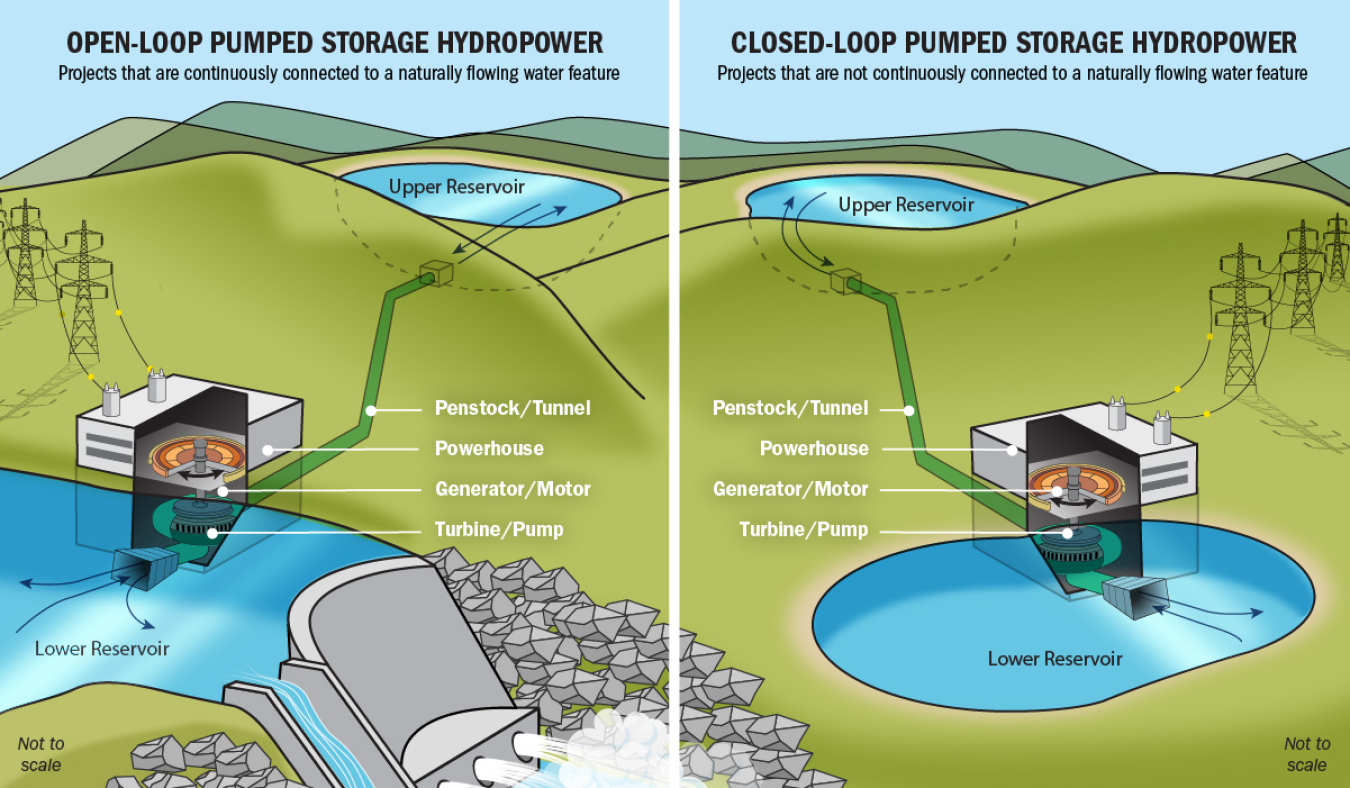Pumped storage hydropower facilities use water and gravity to create and store renewable energy. Learn more about this energy storage technology and how it can help support the 100% clean energy grid the country—and the world—needs.
Water Power Technologies Office
September 1, 2022There’s a place on the Deerfield River, which runs from Vermont into Massachusetts, called Bear Swamp. Bear Swamp might be home to a few bears, but it’s also home to an incredible energy storage solution: pumped storage hydropower (PSH).
PSH facilities use water and gravity to create and store renewable energy. As the country adds more renewable energy to the power grid, moving closer to the Biden administration’s goals of a carbon-free power sector by 2035 and net-zero-emissions economy by 2050, that grid will need reliable energy storage. And PSH is nothing if not reliable.
“Tomorrow’s clean energy grid needs more energy storage solutions,” said Tim Welch, hydropower program manager at the U.S. Department of Energy’s Water Power Technologies Office (WPTO). “Pumped storage hydropower can be one of those solutions, kicking in to provide steady power on demand and helping the country build a resilient and reliable electricity grid.”
How Does PSH Work?
PSH relies on two reservoirs of water, one at a higher elevation than the other. During periods of high energy production—at noon, for example, when there’s plenty of sun and wind for solar power and wind energy—excess energy can be used to pump water up into the higher reservoir. At times of high demand, such as in the evening as people return home and turn on their air conditioning, televisions, and other appliances, PSH facilities can release water from that higher reservoir into the lower pool. When the water flows downhill, it spins a turbine, running a generator, producing clean power.
PSH is a keystone for the modernized grid, standing ready to fill energy gaps and complement other renewable energy sources.
Pumped storage hydropower is the most dominant form of energy storage on the electric grid today. It also plays an important role in bringing more renewable resources onto the grid. Learn more about pumped storage hydropower and how it works!
What’s New About Today’s PSH?
As of 2021, PSH accounted for 93% of utility-scale energy storage in the United States. And yet, most of the country’s PSH facilities were built in the 1970s. In fact, none of the 43 currently running PSH facilities started operation after 1995. But a lot more PSH is on the way—67 facilities were in development across 21 states as of the end of 2019. Together, these new plants could add nearly 53 gigawatts of energy storage to the grid, more than doubling current capacity. Thanks to work funded by WPTO, the technology has improved since the 1970s, and today’s facilities are smaller, more efficient, and cost effective.
PSH facilities being developed today and into the future are built to minimize harm to wildlife and their ecosystems. Most of the new facilities use closed-loop systems, which are separated from natural rivers and lakes

Comparison of Open-Loop and Closed-Looped PSH.
All that extra energy storage is likely to get more affordable, too. For example, Obermeyer Hydro, Inc.’s smaller PSH system doesn’t need an underground powerhouse to operate. Without needing to create this subterranean structure, this model could cut construction costs by as much as 45%.
And this technology is advancing further. A new form of PSH, called Ground-Level Integrated Diverse Energy Storage (GLIDES) systems, pumps water into vessels full of air or other pressurized gases. As more water fills the vessel, it compresses the gases. When the grid needs electricity, a valve opens and the pressurized gas pushes the water through a turbine, which spins a generator. This new technology can come in whatever size best suits a specific site and is expected to last for more than 30 years.
The Future of PSH Plants—Guardians of The Grid
These new PSH technologies are coming at just the right time as the country’s power grid evolves to integrate more variable renewable energy resources. But because new PSH projects require big up-front investments, building a project is a big risk if developers are uncertain about making enough revenue to pay off the costs. To make projects less risky, WPTO is supporting efforts to help developers accurately calculate the potential benefits of a PSH project.
Through the Hydropower and Water Innovation for a Resilient Electricity System (HydroWIRES) Initiative, WPTO launched the PSH Valuation Tool, a web-based platform that takes users through the valuation process presented in the PSH Valuation Guidebook. This step-by-step guide helps developers assess the potential value of an existing or new PSH project and the services it could provide such as energy storage, of course, but also irrigation for farmers, water supply management, and black start capabilities (or restarting the grid following a blackout).
Bear Swamp brought stable, well-paying jobs, energy, and recreation to rural Massachusetts towns. Today’s and tomorrow’s PSH technologies could offer those same benefits to far more communities across the United States, while supporting the 100% clean energy grid the country—and the world—needs.
Stay in the know with WPTO! Learn about the latest hydropower funding opportunities, events, and news by subscribing to the monthly Hydro Headlines and the bimonthly Water Wire newsletters.

